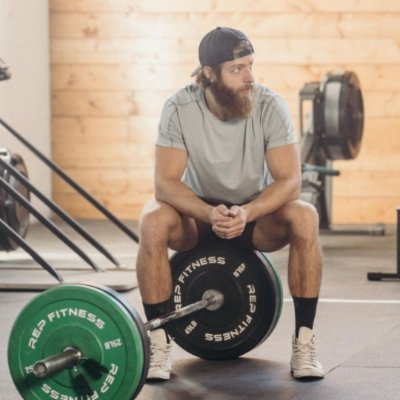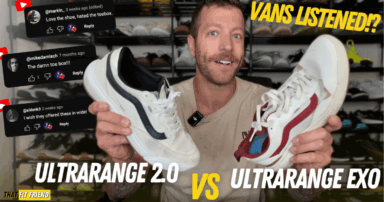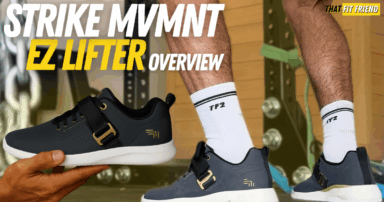The trap bar Romanian deadlift (RDL) is an underrated variation that can be great for training the glutes and hamstrings with heavier weight. This variation can also be easier to perform for some lifters compared to the barbell Romanian deadlift.
Of all the Romanian deadlift (RDL) variations out there, the trap bar RDL is arguably one of the most underrated variations. Far too many lifters pass up trap bar RDLs for dumbbell and barbell RDLs.
The trap bar RDL is great because you can load them heavily and you don’t have to worry about clearing the knees like you do with a barbell Romanian deadlift. This makes them a great option for directing your full attention to your hip hinge.
How To Trap Bar RDL
Trap Bar RDL Benefits and Why Use Them
When it comes to training outcomes, there are a lot of similarities between the trap bar RDL and barbell RDL, but also a few key differences and benefits that come along with using the trap bar.
Below are three of my favorite benefits that come along with using trap bar RDLs for tackling different training goals.
1. Get the Arms Out of the Way
One major benefit of trap bar RDLs is that they take the act of “clearing the knees” out of the equation. When we compare barbell deadlifts versus trap bar deadlifts, one of the major differences is hand position and how that translates to form.
In the barbell RDL, we have to keep the barbell tight to the body while avoiding hitting the knees as we hinge. This can make the barbell RDL a little more technical when you get to heavier weight and want to perfect your form.
In the trap bar RDL, it can sometimes be easier to focus solely on how we’re hinging because the arms are naturally out of the way to the sides. This can be great for beginners who constantly find themselves missing out on barbell RDLs due to hinge form issues.
On that note, this is also why a dumbbell RDL can be a great beginner-friendly option because we can more easily adjust the dumbbells and fully focus our attention on our hinge.
2. Load the Hinge Heavier
The second benefit of trap bar RDLs is that they can be a great RDL variation for working towards heavier hinges, AKA building your hinge strength and capacity.
Most gyms’ dumbbells will stop around 100-120 lbs and if heavier barbell RDLs are tricky for you, then using a trap bar RDL can be an awesome tool for exposing yourself to heavier loads while focusing on your hinge.
In general, most lifters will typically find that trap bar deadlifts are easier to load heavier than traditional barbell deadlifts, and if you find it’s “easier” to lift a heavier trap bar then you may also find that heavier trap bar RDLs are easier for you.
3. Adjustable Handles Help Limit ROM
Another benefit of trap bar RDLs is that you have the option to use a low-handle or high-handle trap bar deadlift setup. Most trap bars will have two different handles which will change the range of motion in which you’re lifting and setting down weight.
If you find that you constantly overreach and flex your torso with heavier RDLs, then using the high-handle trap bar RDL can be an awesome tool for limiting your range of motion (ROM) naturally and the handles will work like a constraint.
Essentially with this high-handle variation, you’ll have less overall ROM to work through with a high-handle setup and can be a nice tool for helping you learn how to limit your ROM to keep more tension on your hamstrings and glutes.
Trap Bar RDL Muscles Worked
The trap bar RDL will work a lot of the same muscles that a traditional barbell and dumbbell will work. However, with this exercise’s change in hand position, some lifters may find that get a little more forearm and upper back work with trap bar RDLs.
For example, with the arms hanging by the sides, the traps and upper back muscles will have to work a little harder to keep the trap bar tracking vertically as you hinge and stand back up.
Coaching Tip: If you’re new to trap bar RDLs, I’d suggest trying them out for a block (3-4 weeks of training) and then swapping them for barbell RDLs in your next block to compare which you resonate best with regarding “feel”.
Trap Bar RDL Mistakes
In the context of trap bar RDL mistakes, there is really only one mistake that I think is super specific to this RDL variation I’d suggest keeping an eye out for. Every other mistake that I’d list would fall into more general RDL mistakes to avoid.
1. Not Gripping the Trap Bar Evenly
The first trap bar RDL mistake is gripping the trap bar unevenly or not being centered on its handles. If you find the trap bar tilting forward or backward while doing RDLs, I’d suggest exploring your hand position.
Just like normal trap bar deadlifts, you want to be centered on the handles to ensure you’re moving the weight relatively vertically as you hinge and not letting the trap bar tilt and take your focus away from your hip hinge.
How to Get More Out of Trap Bar RDLs
If you’re wanting to get even more out of your trap bar RDLs, then you can try performing one of my favorite iterations of this exercise, the banded trap bar RDL. I use this variation with barbell and dumbbell RDLs, too.
To perform a banded trap bar RDL, you’ll want to grab a band that is light to moderate regarding its overall resistance and attach it to a secure base like a squat rack.
Set your trap bar about a body’s length away from the rack and place the band around your hips. Once you’ve done this, you’ll perform trap bar RDLs like normal, but you’ll be adding the band’s resistance during the concentric or standing portion of the movement.
This added band resistance can be awesome for squeezing additional work out of the glutes. Since the band is actively pulling against the glutes as they work to extend, you’ll get some nice added glute gains doing these.
Frequently Asked Questions (FAQ)
Q:Are trap bar RDLs as good as barbell?
Q:Are trap bar RDLs good for beginners?
Q:What muscles do trap bar RDLs work?
Takeaway Thoughts
The trap bar Romanian deadlift is a fantastic exercise for lifters wanting to build their hamstrings and glutes. This exercise is underrated in my opinion and is often underutilized in the gym.
You can load trap bar RDLs heavily and with the arms by the sides of the body lifters often find that it can be easier to focus on their hip hinge with this RDL variation.
If you have additional questions about the trap bar RDL, drop a comment below or reach out to me personally via Instagram (@jake_boly or @that_fit_friend).

















Add a Comment